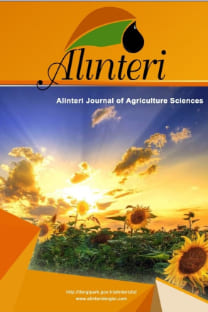Kitinazların Biyolojik Mücadeledeki Etkisi
Fungal patojenler bitkilerde ciddi hastalıklara yol açarak tüm dünyada ekonomik kayıplara neden olurlar. Bu hastalıkların çoğu böcekler ve fungal patojenler tarafından kaynaklanmaktadır. Kitin doğada en bol bulunan biyopolimerlerdendir. Bazı bitkiler tarafından üretilen kitinaz enzimi tarafından katalize edilerek yıkılabilirler. Kitinazlar fungusların hücre duvarının parçalanmasını sağladıkları için bitki savunmasında önemli bir rol oynadığı düşünülmektedir. Kitinazların çoğu in vitro şartlar altında fungal patojenlerin gelişmesini engellemektedirler. Bu derlemede fungal patojenlere karşı dayanıklı bitkilerin geliştirilmesi açısından kitinazların özellikleri sunulmuştur.
Anahtar Kelimeler:
Fungal patojen, kitinaz, transgenik bitki
-
Fungal pathogens cause many serious diseases and result significant agricultural losses around the world. Most of the diseases are caused by insect and fungal pathogens. Chitin is frequently used as a carbon source for fungi that have many chitinases. Chitin is an abundant biopolymer that is relatively resistant to degradation. Chitinases are capable of degrading fungal cell walls and are therefore thought to play a major role in the plant’s response. A number of chitinases have been shown to inhibit fungal growth of various fungi in vitro. The present review describes the properties of chitinase with respect to plant resistant improvement.
Keywords:
Fungal pathogen, chitinase, transgenic plant,
___
- Adams, D.J., 2004. Fungal cell wall chitinase and glucanases. Microbiology 150, 2029-2035.
- Boller, T., 1993. Antimicrobial functions of the plant hydrolases, chitinases and β-1,3-glucanases. In Mechanisms of plant defense responses. Edited by Fritig B, and Legrand M. Kluwer Academic Press, Dordrecht. pp. 391–400.
- Bezirganoglu I, Hwang S.Y., Fang, T.J., Shaw, J.F., 2013. Transgenic lines of melon (Cucumis melo L var.makuwa cv. Silver Light) expressing antifungal protein and chitinase genes exhibit enhanced resistance to fungal pathogens. Plant Cell Tissue Organ culture 112, 227-237.
- Chappell, J., Hahlbrock, K., and Boller, T., 1984. Rapid induction of ethylene biosynthesis in cultured parsley by fungal elicitor and its relationship to the induction of phenylalanine ammonialyase. Planta 161, 475–480.
- Chen, S.C., Liu, A.R., Wang. F.H., Ahammed, G.J., 2009. Combined overexpression of chitinase and defensin genes in transgenic tomato enhances resistance to Botrytis cinerea AFR J Biotechnology 8(20),5182–5188.
- Dana, M.D.L.M., Pentor-Toro, J.A., Cubero, B., 2006. Transgenic tobacco plants overexpressing chitinases of fungal origin show enhanced resistance to biotic and abiotic stress agents. Plant Physiol 142, 722-730.
- Ebel, J., 1986. Phytoalexin synthesis: biochemical analysis of the induction process. Annu Annu Rev Phytopathol 24, 235-264.
- Huynh, QK., Hironaka, CM., Levine, E.B., Smith, C.E., Borgmeyer, J.R., and Shah, D.M., 1992. Antifungal proteins from plants. J Bio Chem. 267, 6635–6640.
- Khachatourians, G.G., 1991. Physiology and genetics of entomopathogenic fungi. In: Arora DK, Ajello L, and Mukerji KG Handbook of applied mycology, Marcel Dekker Inc., New York 2, 613–661.
- Kitajima, S., K. Kamei., S, Taketani., M, Yamaguchi., F.,, Kawai., 2010. Two chitinase-like proteins abundantly accumulated in latex of mulberry show insecticidal activity. BMC Biochem.11, 6-6. Lawrence, S.D., and Novak, N.G., 2006. Expression of poplar chitinase in tomato leads to inhibition of development in colorado potato beetle. Biotechnol Lett. 28, 598–599.
- Li P, Pei Y, Sang X, Ling Y, Yang Z, He G (2009) Transgenic indica rice expressing a bitter melon (Momordica charantia) class I chitinase gene (McCHIT1) confers enhanced resistance to Magnaporthe grisea and Rhizoctonia solani. Eur J Plant Pathol 125, 533–543.
- Lorito, M., Woo S.L., Fernandez, I.G., Colucci, G., Harman, G.E., Pintor-Toro, J.A., Filippone, E., Muccifora, S., Lowrence, C.B., Zoina, A., Tuzun, S., Scala, F., 1998. Genes from mycoparasitic fungi as a source for improving plant resistance to fungal pathogens. Proc Natl Acad Sci (USA) 95, 7860-7865.
- Metraux, JP., Boller, T., 1986. Local and systemic induction of chitinase in cucumber plant in response to viral, bacterial and fungal infections. Physiol Mol Plant Pathol. 28, 161-169.
- Mommsen, T.P., 1980. Chitinase and beta-N-acetylglucosaminidase from the digestive fluid of the spider, Cupiennius salei. Biochim Biophys Acta 612, 361–372.
- Nandakumar, R., Babu, S., Radjacommare, R., Raguchander, T., Samiyappan, R., 2005. Pseudomonas fluorescens mediated antifungal activity against R. solani, sheath blight pathogen Phytopathol Mediterr 41, 109–119.
- Pegg, GF., Young, D.H., 1981. Changes in glycosidase activity and their relationship to fungal colonization during infection of tomato by Verticillium albo-atrum. Physiol Plant Pathol. 19, 371– 38
- Punja, Z.K., and Zhang, Y.Y., 1993. Plant chitinases and their roles in resistance to fungal diseases. J Nematol 25, 526–540.
- Rajasekaran, K., Cary, J.W., Jaynes, J.M., Cleveland, T.E., 2005. Disease resistance conferred by the expression of a gene encoding a synthetic peptide in transgenic cotton (Gossypium hirsutum L.) plants. J Plant Biotechnol 3, 545–554.
- Robert, W.K., Selitrennikoff, C.P., 1988. Plant and bacterial chitinases differ in antifungal activity. J Gen Microbiol 134, 169–176.
- Roby D, and Esquerre-Tugaye M.T., 1987. lnduction of chitinases and of translatable mRNA for these enzymes in melon plants infected with Colletotrichum lagenarium. Plant Sci 52, 175– 18
- Schlumbaum, A., Mauch, F., Vogeli, U., Boller, T., 1986. Plant chitinases differ in antifungal activity. Nature 324, 365–367.
- Tabei, Y., Kitade, S., Nishizawa, Y., Kikuchi, N., Kayano, T., Hibi, T., and Akutsu, K., 1998.
- Transgenic cucumber plants harboring a rice chitinase gene exhibit enhanced resistance to gray mold (Botrytis cinerea). Plant Cell Rep 17, 159–164. Tohidfar, M., Mohammadi, M., Ghareyazie, B., 2005. Agrobacterium mediated transformation of cotton (Gossypium hirstum) using a hetrologous bean chitinase gene. Plant Cell Tissue Organ Cult 83, 83–96.
- Wasano, N., K. Konno., M. Nakamura., C, Hirayama., M. Hattori., 2009. A unique latex protein, MLX56, defends mulberry trees from insects. Phytochemistry. 70, 880-888.
- Zhang, Y.Y., Punja, Z.K., 1994. Induction and characterization of chitinase isoforms in cucumber (Cucumis sativus L.) effect of elicitors, wounding and pathogen inoculation. Plant Sci. 99, 141–150.
- ISSN: 2564-7814
- Başlangıç: 2007
- Yayıncı: Adem Yavuz SÖNMEZ
Sayıdaki Diğer Makaleler
Göksel TOZLU, Ahmet Semih UZUNDUMLU, Okan GEDİKLİ
Kitinazların Biyolojik Mücadeledeki Etkisi
İsmail BEZİRGANOĞLU, Pınar UYSAL
Tüketicilerin Açık Süt Tüketimini Etkileyen Faktörlerin Analizi: Erzurum İli Örneği
Ahmet Semih UZUNDUMLU, Avni BİRİNCİ
Harun YILDIZ, Sefa ACARLI, Selçuk BERBER, Pervin VURAL, Fettah GÜNDÜZ
